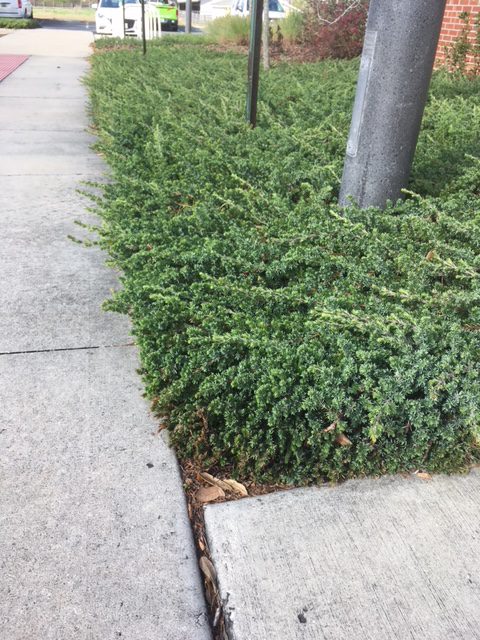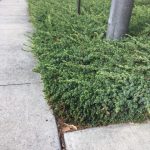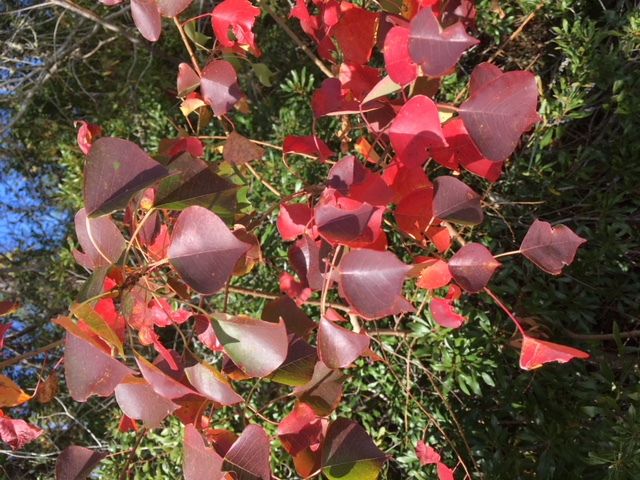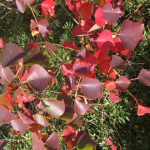
by Julie McConnell | Mar 13, 2018

Shore juniper forms a thick groundcover and tolerates hot, dry sites. Photo: J_McConnell, UF/IFAS
We all know that when you have bare ground in Florida, eventually something unwanted moves in or the soil moves out. To avoid either of these negative outcomes, a good practice is to grow robust vegetative groundcovers, especially if the soil slopes and is at high risk of eroding. Turfgrass is one option, but what if you don’t enjoy caring for a lawn or the site is difficult to maintain or even unsafe to mow? An often overlooked option in our area is Shore Juniper Juniperus conferta.
Although some people find this plant less than exciting, its easy to explain why it can be a good option in certain situations.
- Easy to find at nurseries
- Inexpensive
- Low water requirements once established (you’ll need to turn the irrigation off on these!)
- Salt tolerant
- Evergreen
- Cold tolerant
- Low, spreading growth habit (won’t block view)
- Do not require pruning (junipers cannot tolerate heavy pruning!)
A common cultivar of shore juniper is Blue Pacific Juniper which grows to be about one foot tall but spreads two to three feet wide. The new foliage has a blue cast that gives it the common name. It creeps along the ground and will provide good ground cover to sloping sites. This plant should be planted on 3 foot centers so they have room to expand without crowding. Plant in well-drained soil and apply two inches of mulch on bare soil between plants to reduce weeds while the plants are filling in. Only water until established, then stop automated irrigation and only water as needed. Read more at Establishing Shrubs Florida Landscapes.

by Julie McConnell | Dec 1, 2017

Chinese tallow displays red fall color in North Florida. Photo: J_McConnell, UF/IFAS
In northwest Florida as we transition into fall, we don’t usually see a spectacular display of color change in the forest or our landscapes. Mixed in with the evergreen pines, oaks, and magnolias, we get sporadic spots of yellow and red from our native hickories, sweetgum, and sumac but otherwise it can be rather dull. It’s no wonder that people are reluctant to part with a blaze of red in their landscapes in the form of the invasive Chinese Tallow (Sapium sebiferum L. aka Triadica sebifera L.).
This fast growing, deciduous tree was initially introduced to the United States in 1776 by Benjamin Franklin. It was promoted by the U.S. Department of Agriculture in the early 1900s for the potential to create a soap industry. It was planted as an ornamental because it grows quickly in nearly any type of site condition, has attractive white fruit, and red fall color. Unfortunately, over the years it spread into numerous states and habitats unchecked displacing native vegetation and disrupting wildlife food sources. Eventually, it was recognized as an invasive pest and is currently listed as a noxious weed in Florida, Louisiana, Mississippi, and Texas.
Chinese Tallow is a prolific seed producer and is sexually mature as young as three years and may continue to produce viable seeds to the ripe age of 100. Although some birds eat the berries (part of the dispersal method), sap in the leaves and berries are poisonous to some other animals including cattle.
To prevent the continued spread of this plant, consider removing from your property and replacing with native species. Buy plants from reputable licensed nurseries with good weed management programs. Be able to recognize Chinese Tallow and do not accept plants from well-meaning gardeners who wish to share a foolproof shade tree!

by Julie McConnell | Oct 23, 2017

Cypress twig galls on bald cypress leaves. Photo: J_McConnell, UF/IFAS
Bald cypress Taxodium distichum is a native tree that is commonly planted in landscapes because it is adaptable to many sites and grows quickly. It is an interesting tree because it has soft flat leaves that fall off in the winter like other deciduous shade trees; however, it belongs to the Cypress family which consists mostly of needled evergreens.
Like the other cypresses, bald cypress produces cones in the fall, which is a primary means of reproduction for the species in natural settings. During the same season that cones are maturing, you might also see what looks like cones forming at the tips of branches among the leaflets rather than along the stem. These mysterious growths are not cones but rather twig galls.
Bald cypress twig galls are abnormal growths of leaf bud tissue triggered by the attack of the cypress twig gall midge Taxodiomyia cupressiananassa. In late spring, adult midges lay eggs on new leaves of the bald cypress. As the eggs hatch and midge larvae start feeding on the bald cypress leaves the growth of a twig gall is induced. The larvae take advantage of this gall using it for food and shelter throughout the larval stage and into the pupal stage. After pupation, adults emerge from the galls, mate, and females lay an average of 120 eggs over a two-day lifespan as an adult. This first generation lays eggs on mature leaves which starts the cycle again. The galls formed by the second generation of the year fall off and overwinter on the ground.
The galls do not appear to affect the health of trees overall, although the weight of heavily infested branches may cause drooping. There are many natural enemies of the twig cypress gall midge, so applying insecticides are not recommended since they may cause harm to non-target insects. The simplest management option is to collect and destroy the galls in the spring and fall to reduce populations the following season.
To read more about bald cypress trees or the twig gall please see the following publications:
by Julie McConnell | Sep 18, 2017

A glass jar with the lid secured is one method of bringing a live insect sample to your local Extension Office. Photo: JMcConnell, UF/IFAS
One of the roles of a Horticulture Extension Agent is to help identify pests found in the landscape. Weeds are fairly easy for people to sample, simply take some pictures or dig it up and bring it into the office, but what about insects?
Slow moving insects may be easy to photograph and if their size, shape, and coloration is very distinctive that may be enough for a good identification. But sometimes a photo isn’t worth a thousand words and the best way to get accurate identification is to bring in a physical sample.
The quality of the sample is going to either help or hinder with identification, so here are some tips:
- Never leave samples in a hot car – insects desiccate and become brittle in intense heat. Some details such as number of antennae segments or tarsi on legs are used to positively identify insects; missing pieces can lead to misidentification.
- Bring a live sample if it can be done safely and securely. Small, disposable plastic containers, jars with tightly sealing lids, and reused food or medicine containers work well.
- Small insects such as ants can be collected using a paintbrush dipped in rubbing alcohol which can then be swirled to release the ants into a vial/jar containing a small amount of alcohol. Small soft bodied insects can be collected this way, but may lose their color which may impede identification.
- Crushed or otherwise damaged samples should not be submitted.
- Limit samples to landscape or household pests – your local Extension Office is not a medical facility and is not equipped to handle or process samples that contain bodily fluids, skin scrapings, or similar materials. Please consult a physician for suspected human parasites.
Other helpful information that can be used for identification is the location of the insect, behavior (active night/day), and food source if known.
If insects must be mailed, please follow packaging directions found in this publication Insect Identification Service.

by Julie McConnell | Jul 12, 2017

Coontie (Zamia floridana) planted at the same time but growing at different rates. Photo: J_McConnell, UF/IFAS
When designing landscapes, it is popular to create lines and masses of plants for high visual impacts. Plants are carefully selected to be similar in size and shape at the time of installation. They are all grouped together, so they must be getting the same care, but why do they look different years later? There are several factors to consider when we are trying to figure out why a perfectly matched set no longer looks like a uniform planting.
Although plants may be in the same bed, shadows cast at certain times of the day may reduce sunlight to some sections and not others. This can be caused by structures or trees that have grown over time and changed light patterns.
Supplemental irrigation may also be variable even with the best system design. Over time plants grow and may block sprinkler emitters from reaching some sections of landscape beds. Even if the landscape relies on natural rainfall, there can be still be dry/wet spots in the landscape due to drainage off of hard structures, low areas, or wind direction during storms.
It might be possible to adjust some lighting and watering issues, but there is one factor that many gardeners have not considered – genetics. If plants were grown from seed, than variation is not only possible, but likely. This might be displayed as differences in height and width, foliage color, flower color, speed of growth – all may be influenced by parentage despite best efforts to care for each plant similarly.
Many landscape plants are cultivars. This means they are grown from cuttings or divisions which make them identical to the original plant. When a plant is grown from seed, however, there is no guarantee it will have the same specific qualities as the mother plant.
To combat this phenomenon, landscapers should check sunlight and watering for irregular growth patterns and adjust if needed. If a landscape design requires uniform plants, use named cultivars rather than seedling grown plants in lines or masses.









